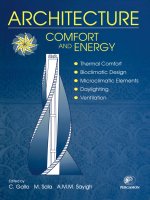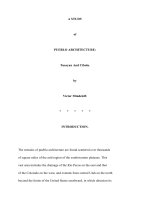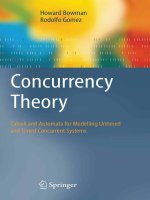Giedion architecture you and me potx
Bạn đang xem bản rút gọn của tài liệu. Xem và tải ngay bản đầy đủ của tài liệu tại đây (12.41 MB, 279 trang )
109 841
sS.
GIEDION
architecture
you
and
me
The
diary
of
a
development
Harvard
University
Press
iy;8
Cambridge,
Massachusetts
1958
by
the
President
and Fellows
of Harvard
College
Distributed
in
Great
Britain
by
Oxford
University
Press,
London
Printed
in
the United States
of
America
Library
of
Congress Catalog
Card
Number
58-6578
FOREWORD
This book is not
based
upon
organized
research.
Books
concerned with
research
into
past
events have
to be
planned
and written
consistently
from
beginning
to end to
clarify
relationships
between
events
and
developments.
No
such
method
is
possible
in
the
case of
this book.
When
one is
standing
in
the
midst of an
evolving
pe-
riod,
only
a
few
signs
can
occasionally
be traced or
noted.
Only
later,
by
checking
backward,
can
one
judge
whether
truly
constituent
facts had been
recognized
or
where
the
argument
had
gone astray.
This
book
cannot
be
more
than
a
diary
of a
development
insofar
as architecture is
concerned
the
diary
of
a
con-
temporary
observer. The
development
forms
and
reforms
as
new
problems appear
on the
horizon.
Evidences are set forth
of the
tragic
conflict between
the
general public
and the
really
creative
artists, architects,
and
planners
that has
existed
for more than a
century.
Some indications
are then
given
of the
ways
in which this
conflict is
becoming
resolved,
or
healed:
some
means
by
which
the
rifts can be
spanned.
In the
realm of
the
architect,
as in that
of
the
painter,
much
has
changed
during
the last
decades.
Creative
spirits
among
the
painters
have
attained
a certain
influence,
and
the
outlook
for both architecture and town
planning
has
undoubtedly
improved
since
the
last
century,
when,
as
snails
destroy
a fresh
green sprout,
the
smear
of the
press
and
the attitude of
the
public
destroyed any
new
archi-
tectonic
beginning.
But let us not deceive ourselves!
Despite
all,
the basic
situation remains
at
a
rather
low
level.
The
prolific
scale-
less
sprawl
of urban
growth
and
the
banal
architecture
of
rebuilt
inner
areas
bequeath
a
heavy
burden
to
posterity.
There are
few
glimpses
of
light;
in
general
there are
only
further
chaos
and stillborn
buildings.
Biological,
social,
and
economic
considerations
have
been
sufficiently
stressed.
Here
we
shall
lay
the
main
emphasis
upon
a
greatly
undervalued
factor:
the
direct
influence
of
aesthetic
values
upon
the
shaping
of
reality.
This is far
greater
than
is
generally
realized.
The
statement,
"I like
this
and
I
don't
like
that,"
is
in
many
cases,
perhaps
in
most,
more
decisive
than
first
costs.
Today's problem
is to
bridge
the
fatal
gulf
between
the
greatly
developed powers
of
thinking
and
greatly
retarded
powers
of
feeling
of
those
in
authority,
no
matter to
what
category
they may
belong.
Once
this
link
has
been
established,
the
search
naturally
follows
for
the
most
creative
designers.
Here,
in
the
field
of
the sciences
just
as
much
as
in architecture
and town
planning,
it
is
only
those
gifted
with
imagination
who
can
find
solutions
to
the
problems
facing
us
today.
Architecture,
You
and
Me
was
first
published
in
German
as
vol.
18
of
the Rowohlts
Deutsche
Enzyklopaedie
under
the
title
Architektur
und
Gemeinschaft
(Hamburg,
1956)
and
our thanks
are due
to the Rowohlt
publishing
house
for
their
permission
to
bring
out
this
enlarged
version
of
the
book
in
English.
Most
of
the
material
first
appeared
in the
form of
articles,
and
a list of
the sources
is
provided
at
the
end.
Occasionally
the
liberty
has
been
taken
of
making
cuts or insertions.
Margjindia providing
continuity
have
been
added between
certain
sections.
The revision
of
Eng-
lish
texts
and translation
of
material
from
German or
French
has been
done
by
Jaqueline
Tyrwhitt
VI
CONTENTS
Parti.
ON
THE
RULING TASTE
tag?
2
Do
We
Need Artists?
1937
6 Art as
the
Key
to
Reality
1937
10
Marginalia
11
The
Tragic
Conflict
1936,
1955
Part
2.
ON
MONUMENTAUTY
22
Marginalia
25
The Need
for a
New
Monumentality
1944
40
On
Monumentally
and
Color,
by
Femand
Liger
1943
48
Nine Points
on
Monumentality
1943
52
Some
Words on
Femand
Leger
1955
56
Marginalia
57
On
the
Space-Emanating
Power of
Contemporary
Sculpture
1949
Part
3.
ON
THE COOPERATION
OF
ARCHITECT,
PAINTER,
AND
SCULPTOR
64
Marginalia
67
On
the
Force
of
Aesthetic
Values
1947
70
Marginalia
72
Architects'
Attitudes
Toward
Aesthetics
1947
79
Architects
and
Politics:
an East-West
Discussion
1949
91
Marginalia
93
Aesthetics
and the Human
Habitat
1953
*
vn
Part
4-
ON
THE FORMATION
OF
THE
ARCHITECT
100
Marginalia
102
On
the Education
of
the Architect
1947
105
Marginalia
106
History
and the
Architect
1955
Part
5.
ON
THE RENEWAL
OF
THE
HUMAN
HABITAT
122
Marginalia
125
The
Humanization
of Urban
Life
1951, 1952
138
The New
Regionalism
1
9 54
Part 6.
ON
THE DEMAND FOR
IMAGINATION
154
Marginalia
157
Social
Imagination
1954,
1956
178
Spatial Imagination 1954,
1956
202
Finale
207
Developments
in Urban
Design
since
1850
213
Acknowledgments
215
Index of Names
220
Subject
Index
viii
Part
i
ON THE
RULING TASTE
Do
We
Need Artists?
Art
as the
Key
to
Reality
The
Tragic Conflict
1937
DO
WE NEED ARTISTS?
A
widespread opinion
Life
today
has become
so
rich
in means of
expression
that art has more or
less
lost
its earlier
purpose;
it has be-
come
absorbed
into life
itself.
Movies,
photography,
radio,
television
the
whole
gamut
of
modern civilization has
taken
its
place.
So what
is the
use of artists?
With
a
few
exceptions,
a
serious artist can no
longer
make a
living
from his art.
Either
he
has
to
be a
salesman
on
the
side,
or he
needs
far-reaching
patronage.
The
great pa-
tron of former
times has become
half
a
dozen smaller
ones.
It
cannot be
denied that the artist
of
today usually
lives
a
dog's
life;
and,
in
doing
so,
he
conforms
to
another
widely
held
opinion,
that an
artist has to
starve
to
be creative!
(This
ethical alibi is
today
falser than
ever.)
Another
opinion
We
certainly
do
not
recommend
a return to a
primi-
tive
way
of
life.
We
love
modern
civilization.
It
is one
of
the
few honest
expressions
of our
being today.
It is a
part
of
us.
But it is
not
the
whole.
A
long
time
ago
man
lost the
key
to the inner
meaning
of
technics,
of
traffic,
of the
daily
round
of his
life. His inner
feelings
became
disassociated from
these,
because
art
offi-
cial art
lost
all
contact with
the
life that
has
grown
out
from
this
civilization.
No
civilization
can
develop
without those
high
notes that
we call
art.
Art?
Feeling?
Means of
expression
are
needed
with no
other
apparent
purpose
than
to
serve as
containers
for
our
feelings.
Every-
one
needs some outlet for
his
feelings.
The
outlet can
be
a
frown,
a
sigh,
or
a
voluptuous
gasp.
The
frown
is
no
help,
since
it
does
not
banish
the
feeling^.
They
remain.
They
accumulate.
So
each man
longs
for
an
environment
that is
the
symbol
or mirror
of his
inner
desires.
Everyone
longs
for a
prolonged
satisfaction
of
these
inner
desires
some
more
ardently,
others
more
contentedly.
There
is
no
political
platform
and
no
community
movement
that
has not some
such
symbol.
There
are
also
pseudo-symbols.
These
always
arise when
the
true
situation,
for
reasons
of
convenience,
is concealed
behind
a
false
fagade.
The
history
of
the
nineteenth
century
is
a
history
of
pseudo-symbols.
The
consequences
are
clear:
For
those matters
which arise
newly
from the innermost
depths
of
a
period,
that are
thrust
aside
in
the
daily
round
of
life,
man
finds no
inner
assurance,
no
guiding
voice.
As
a
result mechanization becomes
rampant
and
life brutalized.
The artist has lost
contact
with
the
public
That
contact
has
been
lost
between
the
artist and
the
general
public
needs
no discussion.
But it is another
matter
to
ask whose
fault
this
is.
The
artist has
it thrown
up
to
him
that his
vocabulary
of
forms
is
no
longer
generally
understandable.
Whose fault
is this? The artist's or
the
public's?
When this
statement is made
it
usually
means
that con-
tact
became lost
when
artists
turned
away
from
naturalistic
representations.
A
slight
historical
correction
It
is
possible
to establish
quite
accurately
just
when
contact ceased
to
exist between
the
artist
and
the
general
public.
When?
With the
dissolution
of
the
craftsmen's
3
guilds,
with
the
proclamation
de la liberti
du
travail on
March
17, 1791.
The abolition
of all
legal
restraints
upon
the
choice
of a trade
left
everyone
free to
select whatever
profession
he
pleased.
Simultaneously
with
this
(seemingly)
creative
freedom
the
artist lost
his former
natural contact
with the
community.
Industrial
development
and artistic
detriment
occurred
simultaneously.
In the
field of
art
itself
a
rift
now
developed.
Artists had to
face
the
question:
how
shall
I
secure
for
myself
the
greatest
possible
sales?
The
consequence:
an art was
born
that catered
to
the
public,
more shameless
than
anything
previously
known
in
history.
This
was
the art of
the
Salons,
of
the
academies of
art,
of
the
gold
medals,
of
the
Prix
de
Rome,
of
officialdom.
The
general public
in
the
most
general
sense
of
this
term,
whether
rich
or
poor
swallowed
it
whole.
Middle-income
groups
raised
their tone
by
hanging engravings
on
their
walls,
made
by
skillful
craftsmen;
noblemen,
industrialists
and financiers
had
the
originals,
for which
they
paid
their
fa-
vorites
as
much
as
a
thousand
francs
per square
centimeter.
This
was
art,
according
to
the critics
appointed
by
the
general public,
who
could see
nothing
and who
had
no
wish to
see
anything.
This
monstrous
apparatus,
this
art
industry
which
took
on
veritable
industrial
dimensions,
eventually
proved
itself
to be of
the utmost
insignificance,
though
its
poisonous
and
befuddling
effect was of
long
endurance.
The
voice of
the
majority,
so
loud
that it drowned
all
others,
proved
utterly
fallacious.
The
general
public
lost
contact -with
art
On
the one
hand there was
this
public
art,
produced
on
an
enormous
scale;
on the other
the
work
of
half a
dozen
painters, upon
whose
shoulders
lay
all tasks of research
and
4
invention.
They
knewright
through
the
entire
century
that
their
position
rendered
all
hope
of
success
or
approba-
tion
quite
impossible.
The
right
to
have
his
work
recognized,
which
is
expected
by
every
normal
individual,
was
almost
always
denied
to
such
artists
throughout
the
last
century
and even
today.
That
these
phenomena
did
not
die
out;
that
there
continued to be
men
who
were
prepared
to
create
their
work
at the
cost
of
their
lives,
is
part
of
the
nature
of
hero-
ism,
which
takes
on
different
forms
in
different
periods.
Outwardly
these
people
lived
their
lives in
creative
isola-
tion.
For the
moment,
they
were
obliged
to
withdraw their
work
more
and
more
from
the
popular
taste
of
the
general
public,
the
critics,
and
the
art
collections.
As
a
result
a
type
of
artist
evolved
whose
work
was
more
and
more
that
of
a
pioneer,
of
a
research
worker,
of
an
inventor.
As the
artist
came to
glance
less
and
less
in
the
direction
of the
public,
he
came
nearer
to
the
possibilities
of
making
contact
with
those
underlying
sources
that
provide
the
nourishment
for
our
period.
Do
we
need
artists?
In
a
period
in
which
the
artist
seems
to
have
lost
all
rights
and
privileges,
should
we
not
say:
Artists can
more
easily
exist
without
the
general
public
than the
general
public
without
the
artists!
Why?
Because
mechanization
runs
amuck
when
there is
no line
of
direc-
tion,
and
when
feeling
cannot
find a
suitable
outlet.
This
interchange
between
reality
and
the
symbols
of
feel-
ing
is
as
delicately
balanced
as the
influence
of
our
uncon-
scious
upon
our
conscious
behavior.
The
moment
it
is dis-
turbed
sound
judgment
disappears.
ART AS THE
KEY
TO
REALITY
Why
is
our
age
so
sick?
Every
creative art
has the
task
of
creating
its own
ap-
proach
to the
world
its
own
key
to the
universe. Its
task
lies
within the
realm
of
irrationality:
to
give
an
expression
to the
emotional
feeling
of a
period.
When
this is
not
done
it
is
a
sign
that that
period
has
lost
contact with
its
own
inner self.
Everyone
knows the
reason
why
our
period
cannot find
its
equilibrium.
It
can
neither control
nor
organize
the
possibilities
that
it
has
itself
produced.
There
is
nothing
more
disturbing
to
the
balance of
our
inner
vigor
than
production
which
becomes an end
in
itself,
and which
has
the
power
(through
the
means at
its
disposal)
to
develop indefinitely.
Inventions
are
important,
since
they
are
the
means
whereby
these
possibilities
may
find a final
inner
freedom.
There
is
no
other
way
by
which
we can
ensure
a
higher
standard
of
living
for
all.
The
problem
starts
when
inventions
are
put
into
produc-
tion.
TTie
machine
produces
as
much
as
man
desires it
should. The
machine
and
its
products
confront
something
that
can be
interpreted
in
many
different
ways
and
yet
never
wholly
grasped:
Man!
The
operation
starts
with'the
pro-
ducer,
continues
with the
distributor,
and
ends
(but
not in
every case)
with
the
consumer.
This
depends
upon
the
way
in
which,
finally,
the
product
reacts
upon
the
general
or-
ganization
of
society
that
we call
its
culture.
It
has
been
shown
that
these
consequences
have
always
been
undeterminable,
socially,
humanly,
and
in
the
domain
of
man's
emotions.
In
a
century
and
a
half
industrialization
has
created
no
new
reality
to
encompass
our
life
cycle.
6
Today,
as
then,
the situation
remains
the
same.
We
have
not
been able
to
cope
with
the new
reality.
We
have
not
mastered
the social
consequences any
better
than
the
human
ones,
for
we
have
created a civilization which
lacks
any
desire
for
tranquillity.
We
do
not know how
to
adapt
ourselves
to
this
civilization,
for
our culture
lacks
an
adequate
balance between
physical
and
mental
tension.
In
short,
we
have
not
found the
key
to
reality,
which
lies
hidden
in
our
emotion.
This is the
matter which we
must
discuss
here.
Art
as
a
substitute
The
rift between
the
newly
created
reality
and emo-
tional
feeling
started
with
the
industrial
revolution:
ungoverned
machines
outcast
feeling,
production
as
an end
in itself
escape
into romanticism.
This
dichotomy
explains
the rise
of
the
public
art
of
the
last
century,
which is
still
the
standard
of taste
of the
gen-
eral
public.
The
officially accepted
art of
the
exhibitions,
the
academies,
the
press:
the art
that
had
real
power
and
that
came
to
govern
the emotional
world
of
the
general
public
proved
to
be
merely
a
drug,
a narcotic.
No
man
can
exist
without
emotion:
he
finds
his
expres-
sion
for this
where
he
can
obtain
it
most
easily.
And
what
is
more
comfortable
than
to
escape
from
the
world,
to shut
one's
eyes
and
make
believe
that one
is
living
in
an
idyllic
period?
One
need
only
thumb
through
the
journals
of
1830
to
1900
to see
this
in
operation.
Today,
a safe
historical
distance
away,
the
public
art
of
the
nineteenth
century
quite
often
has the
charm
of
a
mask
half
banal,
half
demoniac.
It can
be
likened
to
some
pleas-
ant-tasting
medicinal
powder
that
gives
the
organism
a
mo-
mentary
lift before
the
poison
begins
its
fell
work.
The
consequence
of
this
situation
was
that
the
greatest
painters
of
this
period,
the
only
ones
whose
work
continues
to survive
today,
were
forced
to
capitulate
to
the
situation
and become
doomed
to
unimportance.
Production
as
an
end
in
itself
and
in the domain
of
the
emotions
escape
into
romanticism,
go
hand
in
hand
throughout
this
period.
Art
approaches
life
Since
Cubism
assembled
the
possibilities
created
by
the
Impressionists
up
to
the
Fauves,
and
then
found new
ones,
art
has
recovered
its
power
to
exert
an
immediate influence
upon
the
present-day
reality.
But
this cannot
come
about
at once.
This
organically
growing
art
works
like a
biological
medi-
cine,
slowly
and
quietly,
for
it has
to
act on
the
organism
from within.
This is
the function
pursued
by
Cubism,
Constructivism,
and all
other
movements
which,
unlike
those of
the last
century,
do not
present
realistic
representations
of
the
world
and
personal
experiences.
To
the
eye
of the
naturalistically
oriented
observer
the
abstract
forms or
the
organic
fragments
they
create
have no
connection
whatsoever
with
reality.
But
it
turns
out
that
these
paintings
have
the
power
to
radiate
a marvelous
strength,
so
that even
several
decades
later
they
are still
effective
and do
not
grow
outdated.
These
artists
create
not
representations
but
symbols
of
the
contemporary
reality.
This
means
that,
by
presenting
us
immediately
with
the
very
essence
of
a
form,
they
sud-
denly give
us
the
power
of
spatial
penetration
to
acquire
a
completely
new
approach
to
the
world
around
us,
the world
which
we
ourselves have
fashioned.
From
tin
can to iron
construction,
from
the annual
rings
of
a
tree to the furthest
form of
life
that
the
microscope
can
disclose,
from
organic
movement
to
machine
precision,
from
the stone
age
monolith
to
a
tangle
of wire
cable
in
the
8
bed
of
a
stream
wherever
we
look,
this
seemingly
far-
removed
art has
widened
our
experience.
It
has
taught
us to find an
approach
to
ourselves,
and,
thus,
to
create once
again
a
unity
between
feeling
and re-
ality,
which
is
essential
for
the
start of
any
true
culture.
It
has shown us
that
what
appear
at
first
sight
to
be
merely
banal,
nondescript,
utilitarian
objects
can
suddenly
be
transformed
into
vehicles of
feeling,
when
their inner
nature
is
expressed
by
a
painter.
It
has
shown us
the links
that
exist between
the
machine
and the
organism
and
the
machine.
Thanks to
these
paintings
the
loathing
of
ugliness
and
banality
has
been
removed
from
that
reality
which
ex-
ists
because
of and as
part
of
us.
This
is
only
the
beginning,
but
it
has
opened
the
way
for us
to
find anew
the
key
both
to
ourselves
and
to cosmic
forces.
Marginalia
Why
was it
that
an
art filled
with
the
spirit
of
the
period
could
not win
through?
Why
was
it
possible
that,
for over
a
century,
the
painters
and
sculptors
who
determined
the
emotional
make-up
of
the
masses
made
a
pretense
of
having
life,
yet
had no
more
of it
than
the doll
Olympia
in
the
"Tales
of Hoffman"?
The
pictures
of the famous
painters
of that
period
now
molder in
the
cellars
of
art
galleries.
Their
names
have
be-
come
meaningless.
The
whole
production
of the
period
had
little
connection
with
real art.
Even
so it should not be
ignored.
Within
it
lie
the roots
of
that
tragic
rift between retarded emotional
feeling
and
highly
developed
thinking
which
cuts
through
our
period.
Though
the
art
of the
ruling
taste
of
the
last
century
has now
disappeared,
its
influence is still
strong
in
the
emotional
standpoint
of the
general
public,
of
both
great
and
small
administrators,
of
elected
politicians,
and
of
government
officials.
Each
of these believes
himself,
be-
cause
of
his
position,
to be
a
competent
art
critic;
in
this
way
false
idyls
and
sentimental
images
of
the
past
century
live
today.
It
is
still
a
favorite
Sunday
amusement to
ridi-
cule
an art
that
has
sprung
from
the heart
of
our
period.
There are
exceptions
but
the
overwhelming
mass of
the
public
are
still
at the
emotional level
of
the
former
ruling
taste.
It is
enough
to
glance
at
postwar
reconstruction
of
dam-
aged
urban
areas
from
the
bombed
area
around St. Paul's
Cathedral in
London,
or
Berlin,
or
the
reconstruction
of
Sta-
lingrad,
to the
tiny city
of
Saint-Did
Everywhere
we
see
mirrored
the characteristics of
the
ruling
taste:
to erect
sham
facades
before
the realities
of
life.
10
1936,
1955
THE
TRAGIC
CONFLICT
Do
we
need
artists?
Art
as the
key
to
reality.
These
phrases
indicate
the
tragic
conflict,
the
tragic
rift,
of
the
nineteenth
century.
The
nineteenth
century
witnessed
a
greater
expansion
of
material
goods
than
had
ever been
known
before.
Its
think-
ing
was concentrated
upon
obtaining
a
rational
mastery
over
all
the world.
This
approach,
which
had
begun
with
the
Renaissance,
was
now
taken
to
extreme
lengths,
especially
in
connection with
everything
to
do with
technical
develop-
ment.
In this
field
procedures
have
now
been
developed
to
such
a
degree
that almost
anything
that
is
desired can
be
produced.
Man
needs
only
to
press
the
button
labeled re-
search
laboratory
and
the
desired
product
will
be
delivered.
At
the same time
the
nineteenth
century
lived
in a
fog
of
inarticulate
feelings.
It
floundered
between
one extreme
and
another,
reaching
out
blindly
in
all directions.
It
sought
its release
by escape
into
the
past.
It
remained
eternally
un-
certain,
eternally
doubtful,
because it
could
not
find the
key
to
its
inner
self.
Its
emotions stumbled
down
false
tracks
leading
toward substitute
and
second-rate values.
All
this,
caused
by
the
particular predicament
of
the
pe-
riod,
was
well
known
before the
middle
of the
century.
The
statement that
only
posterity
can
estimate
the
true
values
of
a
period
is
one of
those
thin
excuses
behind which
we
shelter
to
escape
our
responsibilities.
It
is
of course true
that
to
evaluate
the
real
meaning
of
public
opinion,
as
expressed
in
the
daily press,
it
is
necessary
to
regard
it from
some dis-
tance
in
time. But
any
person
with
real
judgment
can
recog-
nize
tie
main
predicaments
of
a
period
while
in
the midst
of
its
problems,
just
as
well as
any
later
comer.
When
Heinrich
Heine,
the
German
poet,
paid
his
first
visit to Paris
in
1831,
he
wrote
at
length
about
the
Salon
of
11
that
year,
which
had
a
special
claim
to interest
as it
immedi-
ately
followed
the
revolution
of
1830.
Though
it
was
packed
with
pictures depicting
historic
events,
his
estimate was
"The
art of
today
is
in
distasteful
contrast
to the
actual
scene/'
But
it
was
Charles
Baudelaire,
the
French
poet,
who
found the most tender
spot
when
he
published
his
booklet
on the
Salon
of
1846.
Here
he
placed
his
finger
upon
the
evil
that is
inevitably
bound
up
with
eclecticism:
doubt.
"Doubt,
which
today
is
the
principal
cause
of all
morbid
affections
in
the
moral
world,
and
whose
ravages
are now
greater
than
ever
before
. .
.
Doubt
begat
Eclecticism/'
And a
little later
in
his
chapter,
"On schools
and
journey-
men,"
he
says,
"Doubt,
or
the
absence
of
faith and of
naivete,
is a
vice
peculiar
to this
age
. . .
Naivete"
which is
the
capacity
to
approach
things directly
without
intermediary
"is
a divine
privilege
which almost
all
are
without/'
*
No
period
is
entirely
without
depth,
and
the
nineteenth
century
too
had its
great
artists,
but
the
really
great
those
who
never
lost
the
gift
of "naivet"
were without influence
at that
time,
their
works unknown
and
inaccessible.
The
strength
of the
ruling
taste
overpowered
them.
But real
art
has
one
thing
in
common with the voice
of
conscience:
both utter the truth
which
cannot,
in the
long
run,
be
si-
lenced. The art which at that
time
was
heaped
with
glory
and
success
is
now stacked
in
heaps
in
the cellars
of
all
museums and art
galleries.
It
has become
materially
value-
less.
In
its
place hang masterpieces
of these
misunderstood
artists
such
as
Edouard
Manet
who
suffered
severely
from
lack
of
all
appreciation
in
their
lifetime,
and sometimes
even
destroyed
their
work
in
consequence.
Therefore,
between
the
highly
developed
powers
of think-
ing
of
the
nineteenth
century
and
its
debased
powers
of
feeling
debased
through
the
acceptance
of
substitute
out-
1
Charles
Baudelaire,
The
Mirror
of
Art,
trans,
and
ed.
Jonathan
Mayne
(London,
1955),
pp.
103, 124.
12
letsa
tragic
rift
opened
ever
wider.
T.
S.
Eliot and
others
have
recognized
the
same
phenomenon
among
the
poets
who
were
then
the
darlings
of the
ruling
taste.
These
too
were
unable
to
interlock
thinking
with
feeling,
which alone
can
prepare
the
way
for an
emotional
absorption
of
mental
achievement.
Without this
inner
connection
between
meth-
ods
of
thinking
and
methods
of
feeling
it
is
impossible
to
have
a
positive
way
of life
or
genuine
culture.
In
my
introductory
chapter
to
Space,
Time and
Archi-
tecture
under the
title,
"History
a
part
of
life/*
I
sought
to
express
this
disastrous
conflict,
as
follows:
"We
have
behind
us
a
period
in
which
thinking
and
feeling
were
separated.
This
schism
produced
individuals
whose
inner
development
was
uneven,
who lacked
inner
equilibrium:
split personalities.
The
split
personality
as a
psychopathic
case
does not concern us
here;
we
are
speaking
of
the
inner
disharmony
which
is
found
in
the
structure of
the
normal
personality
of
this
period.
.
.
. The real
spirit
of
the
age
came out
in
these researches
in
the realm
of
thinking,
that
is. But
these achievements
were
regarded
as
emotionally
neutral,
as
having
no relation
to
the
realm
of
feeling.
Feeling
could
not
keep up
with
the
swift advances
made
in science
and
the
techniques."
2
In all
periods
there have been
artists who
have
pleasantly
satisfied
certain
instincts of
the
people
it
was so
in the
times of
Sophocles, Shakespeare,
and Goethe.
But
the
nine-
teenth-century
situation
is
exceptional.
We know
of
no
other
period
in
which
genuine
artists,
those with sufficient
imagination
to
distill
the essence
of
the
period
and
give
it
form,
were,
in
such
great
measure,
debarred
from contact
with the masses.
Franz
Roh,
in
"Studies
of
History
and
the
Theory
of
Cultural
Misunderstandings,"
included
in his book
Der
verkannte
Kiinstler
(The unappreciated
artist),
laid the
cornerstone of
a
Kesonanzgeschichte
(history
of the
recep-
2
Sigfried
Giedion,
Space,
Time
and
Architecture,
jrd
ed.
(Cambridge
1954),
p. 13.









